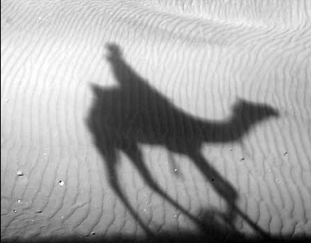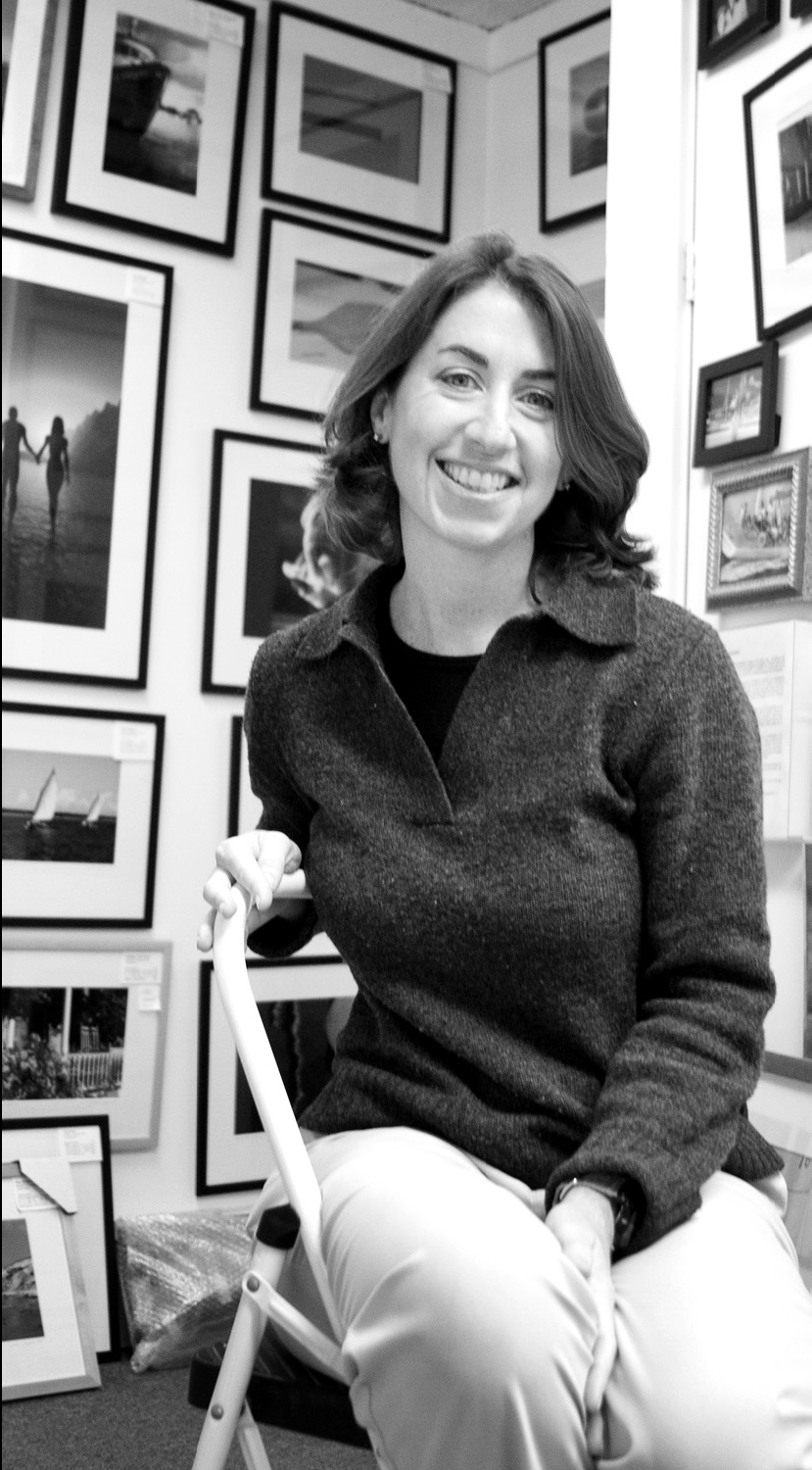By RAC
H
EL
NAVA RO
H
R
When college freshmen look at the photos in their textbook
Introducing World Religions, they may wonder why the Indian woman in the
brilliant colored sari is laughing, or what the desert felt like the day the
Muslim man rested beside his camel, or whether anyone was annoyed that a Hindu’s
sacred cows were standing in the middle of the road. They’ll never know, of
course — unless they talk to Louisa
Gould,
a photographer and gallery owner in Vineyard Haven.
S
he
took the pictures last spring.
Ms. was commissioned by the British academic book publisher
Routledge to travel through India for a month, taking photos for the textbook,
which is due out in a year. she is also a stock photographer and sells her work
in the Louisa
G
allery,
she took a few more pictures than Routledge needs. The final photo count: nearly
10,000. Fortunately, they were digital.
"That would have been 277 rolls of film," she said, plunking
the calculator back on the desk. "I would have gone bankrupt processing it," she
laughed. Since she returned in April, several of the provocative,
color-saturated images have circulated among her friends and patrons, who urged
her to host a show at the gallery.
And so, tomorrow evening from 4 to 6 p.m., Ms. will narrate a
45-minute-long slide show of about 400 photos from the trip. will also serve
homemade Indian foods, using the cookbook and spices she bought on her trip and
has been experimenting with since. India Night will be free to the public.
Ms. was struck by the diversity in India, including religion,
dress, attitude, economics and architecture.
T
here
are
H
indus,
Muslims, Protestants, Catholics, Jains and
S
ikhs.
Ms. learned how clothing distinguishes different Muslim sects, how the colors of
women’s saris hint at which region they’re from, and how headdresses show what
job a
H
indu
man has.
Traveling with her boyfriend J.B. Lamont, a film editor in
Edgartown, Ms.
G
ould
went from place to place in a car for the most part, with a driver. Ms. could
stop and take photographs whenever she wanted. "You see cows everywhere — it
blows your mind," she said. Cows are sacred in
H
induism
and are allowed to roam free.
From the deserts to the cities, Ms. photographed everything
from "beautiful palaces to whole families sleeping on the street."
T
hose
families were in Mumbai, formerly Bombay, where she saw the worst poverty. On
the drive from the airport into town,

heat and dust as captured by island photographer.
the street was lined with slums.
India’s
Many Cultures Captured
By Artist Who Has Many Sides
"In Mumbai I felt the most tensions," Ms. said. "It’s a
huge melting pot. There are many religions and cultures living together."
S
he
sensed tension between
H
indus
and Muslims, Muslims and Parsis, Muslims and the West, India and the West, and
between the different Muslims groups, she said.
"In some places, I wasn’t even comfortable picking up my
camera," she said. One of those places was the "thieves market." "Basically
everything that’s been stolen, you can buy it there," Ms. explained. Brothels
with young prostitutes were located there as well. "I was dying, as a
photographer, to take pictures," she said. "I got two quick shots and then opted
for safety."
While many women in India wear saris, Ms. saw every variety
of clothing in Mumbai — from traditional garb to Western business suits. Mumbai
is the most cosmopolitan city in India and the home of Bollywood, the Hindi film
and television industry. She was struck by the chic women in "slightly Indian"
shirts, tight pants, lots of makeup, designer bags and cell phones. "You see
tons of advertisements for skin whitening," she added.
The population density was striking, Ms.
G
ould
said — even in the desert. "You get out of the car and see no one, and by the
time you take two pictures, there are children running at you from nowhere —
nowhere!" she said. "In India you are never alone."
In the town of Jaisalmer, Ms. was able to take captivating
portraits. "I found the people to be friendliest the further we got from the
cities," she said. "They wanted their photograph taken." The townspeople were
surprised and excited to see the image displayed immediately on the digital
camera. "
T
hey’ve
never seen that before," Ms. said.
hese days, photography assignments guide Ms.
G
ould’s
travels, but long before she was ever a photographer for a living, she was
curious about foreign places and traveled as often as she could.
T
o
date, she has visited about 85 countries.
"When I lived in New York, if we had a long weekend, I’d go
to Istanbul," Ms. said. Living in Brooklyn
H
eights,
she was well situated to shuttle over to JFK, the international airport. Back on
Wall street on Monday, her co-workers couldn’t believe it. "
H
ow
long did you sit in traffic to get out to the Hamptons?" she would ask them in
return.
Ms. worked in mergers and acquisitions on Wall
S
treet
for 10 years, quitting in 1999 to race in the America’s Cup, the most
prestigious regatta in the world. Before flying out to New Zealand, where the
race was being held, the lifelong sailor bought her first professional camera.
Although her team was eliminated early, she sailed professionally for the next
few years — and took plenty of photographs.
"I thought, ‘Wouldn’t it be great to be a sports and travel
photographer?’" she said.
H
er
friends were skeptical at the time, but four years later, nautical photography
led to stock photography and travel photography.
T
hese
days Ms.
G
ould
also dedicates herself to art photography, portraiture and wedding photography.
Next year, she will publish a book featuring her photographs of wooden boats.
Although her mother and her art teacher encouraged her to go
to art school from the beginning, Ms. viewed art as something she’d focus on
later in life. "I thought I wanted to be a senator," she said. "In college I
studied international politics and Chinese — but I always took painting." From
time to time she practices her Chinese in the gallery. "On rainy, stormy days I
put it on, thinking no one’s going to come in," she said. Of course, they always
do.
Only after her plans to teach English in China fell through,
did she apply for an analyst position on Wall "Tiananmen Square happened and I
couldn’t go," Ms.
G
ould
said, referring to the 1989 massacre in Beijing. Even after she took the analyst
job, she still took painting classes at Parsons or the New School at night.
"I’d literally have to sneak out," she said. Leaving at 7
p.m. was the equivalent of taking a half day on Wall Street. She’d get on the
elevator and feel everyone eyeing her painting box. And the looks didn’t stop
when she got to the class. "I’d come in with my little suit," she laughed.
Although she still loves New York, the Island has much to
offer: sailing, a home for her gallery, a market for her photography and family
down the road. And on the Vineyard, art and business go together just fine.
FRI
DAY,
NOVEMBER 17, 2006
